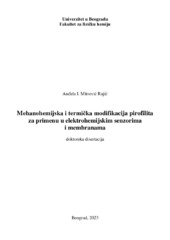Приказ основних података о дисертацији
Mehanohemijska i termička modifikacija pirofilita za primenu u elektrohemijskim senzorima i membranama
Mechanochemical and thermal modification of pyrophyllite for use in electrochemical sensors and membranes
| dc.contributor.advisor | Grbović Novaković, Jasmina | |
| dc.contributor.other | Stojković Simatović, Ivana | |
| dc.contributor.other | Cvjetićanin, Nikola | |
| dc.contributor.other | Šljukić-Paunković, Biljana | |
| dc.contributor.other | Paskaš Mamula, Bojana | |
| dc.creator | Mitrović-Rajić, Anđela | |
| dc.date.accessioned | 2024-01-10T12:21:23Z | |
| dc.date.available | 2024-01-10T12:21:23Z | |
| dc.date.issued | 2023-07-05 | |
| dc.identifier.uri | https://eteze.bg.ac.rs/application/showtheses?thesesId=9455 | |
| dc.identifier.uri | https://fedorabg.bg.ac.rs/fedora/get/o:32190/bdef:Content/download | |
| dc.identifier.uri | https://plus.cobiss.net/cobiss/sr/sr/bib/132316425 | |
| dc.identifier.uri | https://nardus.mpn.gov.rs/handle/123456789/22042 | |
| dc.description.abstract | Kako bi se ostvario cilj disertacije, odnosno dizajniranje elektrohemijskog senzora za detekciju pesticida u hrani i vodi, kao i keramičke membrane za filtraciju, konstruisana je modifikovana elektroda od ugljenične paste sa poboljšanim osobinama i izvršena je termička obrada prirodne gline pirofilita. Modifikacija elektrode izvšena je dodatkom gline. Pre konstruisanja elektrode i membrane, pirofilit je mehanički mleven u mlinu sa kuglama u različitim vremenskim intervalima čime je uticano na mikrostrukturu i morfologiju uzorka. Strukturna, morfološka i termijska karakarterizacija materijala rađena je metodama RSD, FTIR, RVČ, SEM-EDS, DTA i TGA. Utvrđeno je da najbolje karakteristike za konstrukciju elektrohemijskog senzora pokazuje uzorak koji je mleven 15 minuta. Zahvaljujući delaminaciji, savijanju slojeva, smanjenju veličine čestica i kristalita, elektrokatalitička aktivnost modifikovane elektrode je poboljšana. Elektrohemijske karakteristike praćene su cikličnom voltametrijom u H2SO4 i K4[Fe(CN)6]. Rezultati su pokazali da elektroda napravljena od 50% ugljenične paste i 50% mehanohemijski mlevenog pirofilita u trajanju od 15 minuta ima najbolje osobine. Diferencijalnom pulsnom „striping” voltametrijom detektovan je karbendazim pri različitim pH vrednostima u Briton-Robinsonovom puferu. Razvijena metoda je na pH 4 linearna u opsegu od 1–10 ppm, sa r = 0,999 i granicom detekcije od 0,3 ppm. Ispitivanjem termičkih osobina gline, utvrđeno je da se ona može koristiti za konstukciju keramičkih membrana za prečišćavanje otpadnih voda. Glina je termički tretirana na temperaturama od 600 ℃–1200 ℃ pod pritiskom od 50 MPa. Pokazano je da mehanohemijska aktivacija u vremenu od 5 minuta kao i temperatura od 1200 ℃, daju poroznu strukturu sa uniformnom veličinom pora što omogućava konstrukciju membrana. | sr |
| dc.description.abstract | To achieve the goal of the dissertation, i.e. to design an electrochemical sensor for the detection of pesticides in food and water, as well as ceramic membranes for water filtration, a modified carbon paste electrode with improved properties were constructed, while thermal activation at elevated temperatures has been done to constructed ceramic membrane. Modification of the carbon paste electrode was made by clay addition. Before constructing the electrode and membrane, the pyrophyllite was mechanically milled in a ball mill at different time intervals, which affected the microstructure and morphology of the sample. Structural, morphological, and thermal characterization of the material was done using XRD, FTIR, PSD, SEM-EDS, DTA and TGA methods. It was found that the best characteristics for the construction of the electrochemical sensor were shown by the sample that was milled for 15 minutes. Thanks to the delamination and bending of the layers, the size of the particles and crystallites decreases, and the electrocatalytic activity of the modified electrode is improved. Electrochemical characteristics were monitored by cyclic voltammetry in H2SO4 and K4[Fe(CN)6]. The results showed that the electrode made of 50% carbon paste and 50% mechanochemically ground pyrophyllite for 15 minutes had the best properties. Carbendazim was detected by differential pulse stripping voltammetry at different pH in the BrittonRobinson buffer. The developed method is linear at pH 4 in the range of 1–10 ppm, with r = 0.999 and a detection limit of 0.3 ppm. Examining the thermal properties of clay, it was determined that it can be used for the construction of ceramic membranes for wastewater treatment. The clay was thermally treated at temperatures of 600 ℃–1200 ℃ under a pressure of 50 MPa. It was shown that mechanochemical activation in a time of 5 minutes, as well as a temperature of 1200 ℃, gives a porous structure with a uniform pore size. | en |
| dc.format | application/pdf | |
| dc.language | sr | |
| dc.publisher | Универзитет у Београду, Факултет за физичку хемију | sr |
| dc.rights | openAccess | en |
| dc.rights.uri | https://creativecommons.org/licenses/by-nc/4.0/ | |
| dc.source | Универзитет у Београду | sr |
| dc.subject | elektrohemijski senzor, modifikovana elektroda od ugljenične paste, prirodna glina pirofilit, mehanička modifikacija, vreme mlevenja, keramička membrana, termički tretman, karbendazim, diferencijalna pulsna „striping” voltametrija | sr |
| dc.subject | electrochemical sensor, modified carbon paste electrode, natural pyrophyllite clay, mechanical modification, grinding time, ceramic membrane, thermal treatment, carbendazim, differential pulse stripping voltammetry | en |
| dc.title | Mehanohemijska i termička modifikacija pirofilita za primenu u elektrohemijskim senzorima i membranama | sr |
| dc.title.alternative | Mechanochemical and thermal modification of pyrophyllite for use in electrochemical sensors and membranes | en |
| dc.type | doctoralThesis | |
| dc.rights.license | BY-NC | |
| dc.identifier.fulltext | http://nardus.mpn.gov.rs/bitstream/id/158282/Disertacija_14592.pdf | |
| dc.identifier.fulltext | http://nardus.mpn.gov.rs/bitstream/id/158283/Izvestaj_Komisije_14592.pdf | |
| dc.identifier.rcub | https://hdl.handle.net/21.15107/rcub_nardus_22042 |



